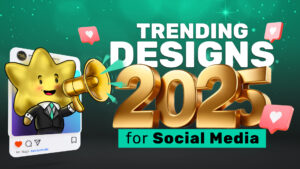Understanding Typography is an essential element in the world of graphic design, where the arrangement of text plays a critical role in how a message is conveyed and perceived. While many may overlook typography as merely the selection of fonts, it is, in fact, a comprehensive art and science that profoundly influences the effectiveness of communication through design.
Understanding Typography is more than just the selection of typefaces; it encompasses the entire arrangement of text on a page or screen, including the size, spacing, and alignment of characters. In graphic design, typography is pivotal in ensuring that the content is not only legible and readable but also visually appealing, enhancing the overall aesthetic of the design.

What is Typography?
At its core, typography is the art and technique of arranging type to make written language legible, readable, and visually appealing. It goes beyond mere aesthetics; typography is about how the text is presented to convey meaning effectively. This involves selecting typefaces, point sizes, line lengths, line-spacing (leading), and letter-spacing (tracking), and adjusting the space between pairs of letters (kerning).
Understanding Typography is a blend of creativity and precision. A well-executed typographic design can communicate emotions, set a mood, and establish a visual hierarchy, guiding the reader through the content in an intuitive and engaging way.

The Importance of Typography in Graphic Design
Typography is not just a decorative element in graphic design; it is a fundamental tool for effective communication. The importance of typography can be understood through its impact on various aspects of design:
Enhances Readability
One of the primary functions of understanding typography is to enhance readability. High contrast between text and background is essential, particularly for users with visual impairments. The psychology of colors also plays a significant role in typography. For example, warm tones can create a friendly and inviting atmosphere, while cooler shades can evoke calmness and professionalism. By carefully selecting colors and typefaces, designers can make the text more accessible and engaging for all users.
Sets the Mood and Tone
Typography is akin to music in design—it sets the mood and tone of the content. The choice of typefaces, the spacing, and even the alignment of text can influence the visual atmosphere, convey emotions, and establish the overall aesthetic. For instance, a bold, sans-serif typeface might convey strength and modernity, while a delicate script font might evoke elegance and sophistication. By manipulating these elements, designers can create a typographic style that aligns with the message they want to communicate.
Establishes Hierarchy
In any design, establishing a clear hierarchy is crucial to guide the reader’s eye through the content in the intended order. Typography plays a key role in this process by creating different levels of importance through size, weight, and style. For instance, headings are often larger and bolder to draw attention, while body text is smaller and more uniform to facilitate reading. By organizing text hierarchically, designers can ensure that the most important information is noticed first, followed by supporting details.
Reflects Brand Identity
Typography is a powerful tool for establishing and reinforcing brand identity. Consistent use of fonts across all brand touchpoints helps build familiarity and trust with the audience. Just as a logo represents the visual identity of a brand, typography represents its voice. For example, a luxury brand might use elegant serif fonts to convey sophistication, while a tech company might opt for a clean, modern sans-serif font to express innovation. The right typographic choices can evoke specific emotions and associations, making them integral to brand communication.
Supports Visual Balance
The size, weight, and style of typography significantly impact the visual balance of a design. Larger, bolder text naturally attracts more attention and can be used to create focal points, while lighter, more delicate fonts can provide contrast and relief. Proper use of typography can create a harmonious composition that guides the viewer’s eye smoothly across the design, ensuring that no single element overwhelms the others.

Key Elements of Typography
To fully understand typography’s role in graphic design, it’s essential to delve into its key elements, each contributing to the overall impact of the text.
Typefaces and Fonts
While often used interchangeably, the terms “typeface” and “font” refer to different concepts in typography. A typeface is a family of related fonts, while a font is a specific set of characters of a particular size, width, and style. For example, Times New Roman is a typeface, while Times New Roman, regular, 12-point, is a font. In graphic design, choosing the right typeface and font is critical to conveying the intended message and maintaining visual consistency across different media.
Hierarchy
Hierarchy in typography refers to the arrangement and organization of text to indicate its importance. It helps readers navigate the content by distinguishing between headings, subheadings, and body text. This hierarchy is created through variations in text size, color, contrast, and positioning. For instance, in a blog article, the title might be the largest and most prominent text, followed by subheadings in a smaller but still noticeable font, and finally, the body text in a more uniform and understated style.
Kerning, Leading, and Tracking
These terms refer to the spacing aspects of typography. Kerning is the adjustment of space between individual characters, ensuring that they are evenly spaced and visually pleasing. Leading refers to the space between lines of text, which affects the readability and overall appearance of the text block. Tracking is the overall spacing across a word or passage of text, influencing how open or crowded the text appears. Proper adjustment of these elements can enhance the readability and visual appeal of the text.
White Space
White space, or negative space, is the area around text and images that is left unmarked. While often overlooked, white space is a critical component of typography that helps to prevent a design from feeling cluttered. It makes the text easier to read and allows the design to “breathe,” creating a more relaxed and comfortable viewing experience. In typography, white space can also be used to draw attention to specific elements or create a sense of balance and harmony in the design.
Alignment
Alignment in typography refers to the positioning of text relative to other design elements or the layout grid. Proper alignment creates order and harmony, guiding the reader’s eye naturally through the content. Whether the text is left-aligned, centered, right-aligned, or justified, the choice of alignment can significantly impact the readability and aesthetic appeal of the design. Consistent alignment helps to create a clean, professional look and reinforces the overall structure of the design.
Conclusion
Typography is much more than just the selection of fonts; it is a critical tool in the graphic designer’s arsenal for communicating effectively. Understanding the nuances of typography allows designers to create work that not only looks good but also serves its intended purpose—whether that’s conveying a brand’s identity, guiding the reader’s experience, or simply making text more enjoyable to read. Mastery of typography requires practice, experimentation, and a keen eye for detail, but the results are well worth the effort.





